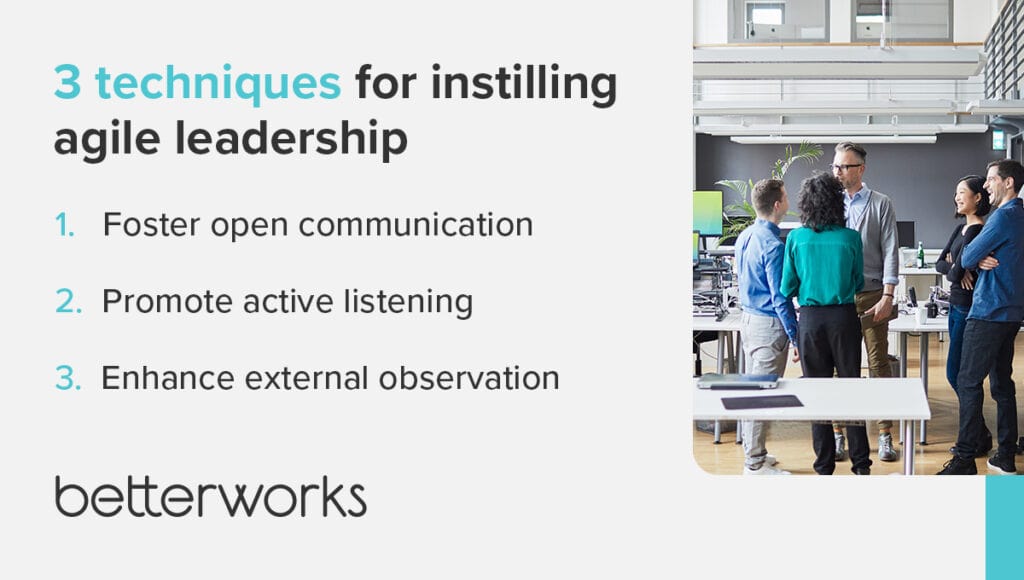- How does agile leadership benefit your business?
- Traditional organizations vs. agile organizations
- 3 principles of agile leadership
- Cultivating agility: Tips for creating an agile workplace
- How to develop agile leaders
- Agile leadership styles and personalities in leadership
- 3 key techniques for instilling agile leadership
- Embrace agile leadership for continued success
Constant change is the new normal. To remain competitive in this fast-paced climate, you need an organizational culture that adapts to change. HR leaders who embrace agile leadership principles create an innovative, problem-solving workforce that’s ready for any challenge.
As a broad set of principles and practices, agile leadership helps employees become more efficient, effective, and productive. But what is agile leadership, and what does it look like in practice? How can you develop agile leaders in your business?
Read on for real-life examples and practical strategies that illustrate the key characteristics and behaviors of agile leaders. You’ll also receive actionable steps to develop agile leaders within your company.
How does agile leadership benefit your business?
Business agility is essential in a constantly evolving world of work. Agile leadership borrows from agile software development to help companies pivot quickly in response to internal and external factors. Agile software development is a tech-focused project management approach that’s expanded to a widely practiced and respected leadership philosophy across industries. This is further amplified by the integration of AI project management, which streamlines decision-making, optimizes resource allocation, and accelerates innovation cycles.
The agile method relies on frequent check-ins and early detection of obstacles, which improve team effectiveness and keep work flowing. Agile relies on sprints to complete tasks within a set time frame, even if that work isn’t flawless the first time. With the agile method or using an agile software development, “failing fast” means iterating, learning, and adapting faster.
Agile leadership is a leadership style that strives to remove roadblocks to success so that employees can be more effective and productive. Agile leaders have frequent check-ins with team members to surface and address concerns early.
One of the hallmarks of the agile method is its iterative work approach. Agile leaders encourage team members to experiment with new ways of working, quickly test new ideas, and refine them over time.
Agile leadership, like the method that inspired it, relies on transparent conversations to stay aware of factors that could influence success. Agile leaders face challenges head-on as they arise, helping their teams achieve their desired outcomes. Consider a manufacturer facing a talent shortage. HR leaders might meet with strategic operations leaders to discuss the situation and get input on how to improve recruiting, retention, and skills training.
An agile management style supports each team member individually and also promotes higher team functioning collectively. Because employees are empowered by open communication with their managers, they can take ownership of their work and move forward successfully. Because these individuals are also working as a team, you can quickly unleash the full power of your workforce.
Traditional organizations vs. agile organizations
Traditional organizations are susceptible to bureaucracy. Since all important decisions come from the top, leaders can be slow to respond to change. This can have huge consequences. If a company can’t evolve quickly (or at all), it risks losing relevance and market share.
Agile organizations rely less on legacy rules and processes and more on updating processes and maximizing employee potential to facilitate better work. They decentralize power and recognize the value from listening to front-line employees. When change occurs, agile organizations react quickly.
No organization succeeds with every project or initiative, but agile teams look at failures and disappointments as opportunities to learn and improve. Taking an iterative approach allows groups within the organization to experiment, learn, and make adjustments that produce better results.
3 principles of agile leadership
Agile leadership is guided by key principles that empower leaders to foster adaptive, collaborative, and high-performing teams. By understanding and applying these principles, leaders can unlock the true potential of agile leadership and drive team success.
Discover some of the fundamental principles that enable agile leadership to thrive — and transform teams into agile powerhouses.
Empowering and trusting teams
Agile leadership is based on the belief that individuals and teams are self-organizing and capable of making good decisions when given autonomy and trust. Agile leaders empower their teams by providing a clear vision and goals, encouraging collaboration, and removing obstacles. They promote a culture of ownership, accountability, and continuous improvement.
Embracing and adapting to change
Agility is synonymous with flexibility and adaptability. Agile leaders embrace change as an opportunity rather than a disruption. They promote a culture of experimentation where teams are encouraged to try new approaches and learn from failures.
Agile leaders are open to employee feedback, encourage learning, and are willing to change their minds based on new information or changing market conditions. They understand that agility is necessary for responding to evolving customer needs and a changing business climate.
Facilitating collaboration and communication
Agile leadership recognizes the value of collaboration and effective communication in driving successful outcomes. Agile leaders use agile project management software where cross-functional teams work closely together, break down organizational silos, and promote a culture of shared responsibility. They encourage open and transparent communication across the organization, creating feedback loops. These leaders also emphasize the importance of sharing goals, priorities, and expectations. This helps teams align their efforts and make informed decisions.

Cultivating agility: Tips for creating an agile workplace
Building an agile workplace requires a combination of strategic planning, cultural shifts, and effective implementation. By following these tips, HR leaders can create an agile workplace that thrives in today’s fast-paced business landscape.
Learn how to create a workplace that embraces agility and drives sustainable success.
Foster a culture of continuous learning
Learning opportunities help to sustain team and leadership motivation while encouraging the open discussion of important topics. Encourage teams to work together across departments to share knowledge, ideas, and feedback.
HR leaders can provide the workforce with choices for continuous learning, such as training, workshops, or internal knowledge-sharing sessions.
Emphasize iterative feedback and adaptation
Encourage regular feedback loops within teams and across the organization. Feedback sources can include co-workers, customers, and other stakeholders. Emphasize the importance of data-driven decision-making and experimentation. Encourage teams to iterate and adapt their work based on the insights collected from customers, users, or other relevant parties
Promote employee autonomy
Agile workplaces thrive when individuals and teams are empowered to own their work. Leaders should provide clear goals and objectives, then let their people decide how to achieve those outcomes. Encourage teams to self-organize, make decisions collectively, and take responsibility for their outcomes. Trust your teams to deliver results, and provide support along the way.

How to develop agile leaders
Before you can implement an agile workforce transformation, you have to identify the qualities of an agile leader.
Traditionally, leadership candidates have been selected for being high performers in their previous roles. But performance as an individual contributor doesn’t necessarily mean someone has leadership qualities or the ability to guide agile teams. Instead, seek to identify effective leadership candidates who are curious, communicate well, look to innovate, and can adapt quickly to change.
You can help high-potential team members become agile leaders. Once you’ve identified candidates with the right leadership qualities, provide the support so they can further develop those traits. HR and learning and development teams can collaborate on training programs for agile leaders.
One of the best ways to develop agile leaders is by giving them time to learn on the job. Cross-functional training is one of many approaches. By shadowing agile leaders, leadership candidates can observe agile behaviors in action and then put them into practice.
Agile leadership styles and personalities in leadership
Many of the biggest companies are thriving under agile leadership.
Former Starbucks CEO Kevin Johnson exemplified the principles of agile leadership during his tenure. By embracing digital innovation, promoting collaboration, and prioritizing customer-centricity, Johnson demonstrated his ability to adapt to changing consumer and market trends. His strategic vision and willingness to embrace change drove growth for Starbucks.
Dr. Marc Harrison illustrated agile leadership while he was president and CEO at Intermountain Healthcare by implementing structured 15-minute huddles across the organization’s 23 hospitals. These daily gatherings offered a platform for team members to express their thoughts, concerns, and ideas from the bottom up. This approach gave leadership a better understanding of what was happening on the front lines, whether it was a problem to resolve or an idea to work on.
Jeff Bezos, the visionary leader behind Amazon, built a culture that encouraged innovation across the workforce, especially when it helped customers. With Bezos’ “multiple paths to yes” approach, team members and executives throughout the company could approve iterative ideas rather than having bureaucracy stall innovation.
3 key techniques for instilling agile leadership
Building an agile organization requires more than processes; it calls for a cultural shift that empowers leaders at all levels to embrace agility. By following these steps, you can create a culture of adaptability, innovation, and continuous improvement.
Foster open communication
Agile leaders communicate openly and transparently, which helps them identify obstacles to their team’s success.
HR plays a key role in fostering open communication. Provide training and resources on effective communication techniques to help leaders engage in meaningful conversations with their teams. Build transparent communication into ongoing processes, such as regular check-ins or anonymous surveys. Build a culture of psychological safety where employees feel safe expressing their thoughts, concerns, and ideas — and know that managers and executives take that communication seriously.
Promote active listening
Agile leaders are always listening for feedback from stakeholders — front-line employees, in particular. These leaders understand that practical process solutions are most likely to come from the people most intimately familiar with the day-to-day work.
Implement practices such as regular feedback conversations, one-on-one meetings, and structured communication channels to ensure that leaders actively listen to their teams, understand their perspectives, and respond to their needs with empathy. These practices will also help employees know where to direct specific types of communication, which helps leaders see and respond quickly.
Enhance external monitoring
Agile leaders are in tune with their workforce and with external factors including changes among customers, the industry, or the broader economy. They consider these observations in the context of the organization’s strategic priorities and regularly reassess them for relevance. Agile leaders are grounded by principles but prepared to act quickly to stay focused on customer and workforce needs.
HR can help leaders develop this external awareness through training focused on observational skills. Mentoring, coaching, and subject-specific training can help leaders better understand what to look for in their industry — including opportunities for innovation.

Embrace agile leadership for continued success
Agile leadership presents a promising path for organizations seeking to adapt to an ever-changing business environment. HR plays a crucial role in helping executives, managers, and employees embrace agile principles to unlock new ideas, continuous improvement, and the full potential of the workforce.
With agile leaders at the helm, your organization can navigate uncertainty with confidence, update processes as needed, and embrace innovation.
Want to learn more about business agility? Check out “What Is Agile Transformation?”
What is Agile Transformation?







